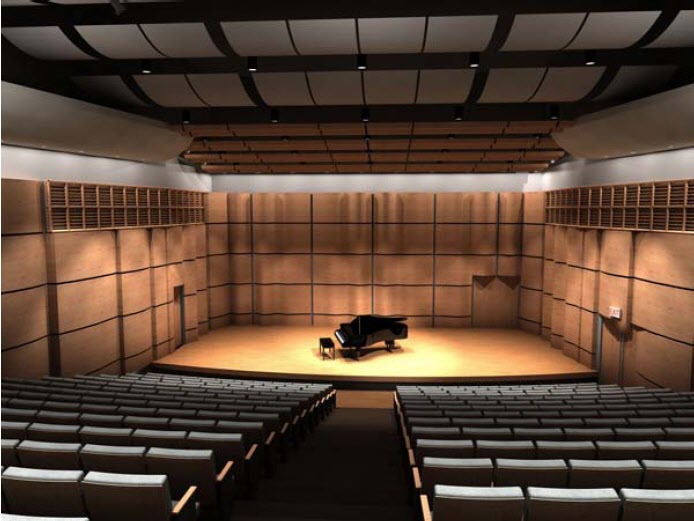Exploration
Critical Listening Rooms:
 In the early 1980s, after forming RPG Diffusor Systems, Inc., Dr. D'Antonio developed a room design to accurately audition music in a 2 channel recording studio control room. The approach, called the Reflection Free Zone (RFZ), controlled first order reflections with broadbandwidth absorption forming a spatio-temporal reflection free zone and reflection phase grating diffusors were used on the rear wall to essentially create passive surround sound. As the industry has evolved from 2-channel to multi-channel, a new room design was developed in collaboration with George Massenburg at Blackbird Studios, Studio C, Nashville, TN. For an overview of critical listening room evolution we invite you to download Mono2Surround.
In the early 1980s, after forming RPG Diffusor Systems, Inc., Dr. D'Antonio developed a room design to accurately audition music in a 2 channel recording studio control room. The approach, called the Reflection Free Zone (RFZ), controlled first order reflections with broadbandwidth absorption forming a spatio-temporal reflection free zone and reflection phase grating diffusors were used on the rear wall to essentially create passive surround sound. As the industry has evolved from 2-channel to multi-channel, a new room design was developed in collaboration with George Massenburg at Blackbird Studios, Studio C, Nashville, TN. For an overview of critical listening room evolution we invite you to download Mono2Surround.
Core Learning Environments: What did you say? There is a tendency to over use absorption in core learning spaces. The ear/brain processor can fill in a substantial amount of missing information in music, but requires more detailed information for understanding speech.
The speech power is delivered in the vowels (a, e, i, o, u and sometimes y) which are predominantly in the frequency range of 250Hz to 500Hz.
The speech intelligibility is delivered in the consonants (b, c, d, f, g, h, j, k, l, m, n, p, q, r, s, t, v, w), which requires information in the 2,000Hz to 4,000 Hz frequency range. Why would we want to absorb these important frequencies on ceilings of speech rooms and prevents them from fusing with the direct sound and making it louder and more intelligible? What is needed is to increase the signal to noise ratio, where the signal is the direct sound plus early reflections and the noise is reverberation and unwanted external and internal noise intrusion.
Download Dr. D'Antonio's Powerpoint on Modern School Acoustics to explore proposed designs.
What did you say? There is a tendency to over use absorption in core learning spaces. The ear/brain processor can fill in a substantial amount of missing information in music, but requires more detailed information for understanding speech.
The speech power is delivered in the vowels (a, e, i, o, u and sometimes y) which are predominantly in the frequency range of 250Hz to 500Hz.
The speech intelligibility is delivered in the consonants (b, c, d, f, g, h, j, k, l, m, n, p, q, r, s, t, v, w), which requires information in the 2,000Hz to 4,000 Hz frequency range. Why would we want to absorb these important frequencies on ceilings of speech rooms and prevents them from fusing with the direct sound and making it louder and more intelligible? What is needed is to increase the signal to noise ratio, where the signal is the direct sound plus early reflections and the noise is reverberation and unwanted external and internal noise intrusion.
Download Dr. D'Antonio's Powerpoint on Modern School Acoustics to explore proposed designs.
Acoustical Shapes: We have developed a proprietary Shape Optimization program combininb boundary element and multi-dimensional optimization techniques to create shapes that compliment contemporary architecture in the same way that coffered ceilings, statuary, balustrades, columns and relief ornamentation complemented classic architecture. We invite you to review an introductory white paper on shape optimization
We have developed a proprietary Shape Optimization program combininb boundary element and multi-dimensional optimization techniques to create shapes that compliment contemporary architecture in the same way that coffered ceilings, statuary, balustrades, columns and relief ornamentation complemented classic architecture. We invite you to review an introductory white paper on shape optimization

